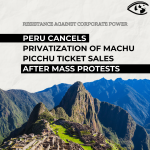EuroZone Profiteers: Spain
An Airport Without Planes, and the Never-Ending Property Boom

Where: Spain.
Why: Seduced by low interest loans, local authorities and real estate speculators went on a spending spree. Initially prices skyrocketed for property before they crashed after 2008. Meanwhile the airports, roads, even movie sets that were built generated hardly any revenue.
Outcome: Spain was forced to request upto €100 billion in potential loans by the European Financial Stability Facility and the European Stability Mechanism in exchange for strict restructuring of the banking sector. Borrowing costs hit 7.3 percent in July 2012
A joke making the rounds in Spain: It’s the first country in the world to inaugurate a pedestrian airport. Costa Azahar airport sits, without planes, just outside the Mediterranean town of Castellón. Welcoming visitors to this oddity is a 24-meter high copper statue of Carlos Fabra, the former regional boss of the right-wing Partido Popular (PP) and head of the province from 1995 to 2011. He was also the driving force behind the scheme that became a punch line.[164]
One of the principal backers of €150-million project was Dexia Banco Sabadell, which provided an €18.5 million loan, and joined with several other banks to issue a €39-million syndicated loan.[165] Two years after the airport was launched, not a single airline had scheduled flights, and the government had to guarantee the development loans.[166]
Some 75 kilometers south, a five-star, luxurious Hilton hotel offers panoramic views of Valencia, Spain’s third largest city. The €110-million project—financed by Eurohypo—opened in 2008, and declared bankruptcy a year later.[167]
Across the country, in Galicia, Depfa provided a €90-million loan to build a privately operated toll road, one of many that would struggle to generate sufficient revenue for the operators to pay back the lenders.[168] To the north, in the Basque town of Bilbao, Crédit Agricolefinanced the building of the Bilbao Exhibition Centre (BEC) as part of a syndicated loan of €150 million.[169] The project eventually cost some €600 million, once again at public expense.[170]
“German banks financed Spain's savings and commercial banks, which needed extra funds for high-risk mortgages,” wrote Robert Tornabell, a professor of international banking and finance at Barcelona's ESADE Business School. “Developers got rich, selling the idea that everyone was going to win because property would always go up—never down—in value.”[171]
This pipe dream of future prosperity was also promoted heavily by Spanish construction companies that were allegedly donating generously to politicians in Partido Popular, which ran Spain from 1996 to 2004.[172]
For example, Fomento de Construcciones y Contratas (Barcelona) and Obrascón Huarte Lain and Sacyr Vallehermoso (Madrid)—made a series of undisclosed payments to senior party officials. The details were listed in handwritten notes kept by Luis Bárcenas, the party’s former treasurer and his colleague Álvaro Lapuerta, according to an investigation by El País newspaper in Spain.[173]
Fueled by cheap loans and greased with bribes, Spanish public authorities and private developers embarked on a building bonanza. “During those giddy years, few wielded more power in Spain than its lords of construction, a group of men who used the country’s post-dictatorship economic miracle to build their companies into behemoths feared more than they were loved,” wrote Miles Johnson in a Financial Times account of the era.[174]
All three companies won billions of euros in Spanish government contracts and concessions during the boom times: For example, Fomento de Construcciones y Contratas estimated that it won over €3.75 billion in Spanish construction contracts in 2008, Sacyr estimated it won €2.55 billion in Spanish construction contracts that year, and Obrascón Huarte Lain reported €1.02 billion in domestic construction work in 2008.[175]
The money for this building spree had to come from somewhere. Big banks in Belgium, Germany, and France—recently released from the fetters of government ownership and regulation, and looking to expand across Europe—were more than happy to help.
Take for example Metrovacesa, once Spain’s largest real estate company, which aspired to become the largest developer in all of Europe. It racked up €7 billion in debt buying properties all over the continent during the real estate boom, borrowing heavily from Hypo Real Estate.[176] In April 2007 Metrovacesa bought the most expensive U.K. property in history, the 45-story HSBC bank headquarters in Canary Wharf, London. The HSBC tower cost £1.1 billion (€1.35 billion), and was purchased with the help of a £810 million (€1 billion loan) from HSBC itself.[177]
A year and a half later, property values fell, and banks would not extend Metrovacesa additional credit. The company was forced to take a loss, and sell the Canary Wharf high rise back to HSBC to cover its debts.[178]
Eurohypo ran into the same problems. It owned a fifth of Inmobiliaria Colonial, a €12-billion property company with offices for rent in Barcelona, Madrid, and Paris that was forced to seek outside buyers in 2008 to stave off collapse.[179]
Provincial governments soon followed suit in declaring bankruptcy. When the money flowed, the province of Valencia splurged on a €2.4 billion harbor to host the 2007 America’s Cup, €1.1 billion on the City of Arts and Sciences, and a Formula One racetrack inside the city.[180] In July 2012, it became the first to ask the Spanish government for a bailout—to help manage its €20.76 billion debt.[181] Within weeks, half of the country’s 17 regions followed suit—asking for help paying off an astronomical €140 billion in debt.[182]
“Chancellor Merkel rightly criticized the Spanish [state] activities for allowing the development of [the real estate] bubble,” wrote Vicente Navarro, professor of public policy at Pompeu Fabra University in Barcelona. “But she should have included German banks in that criticism.”[183]
Minder, Op. Cit.
[165] Aeropuerto de Castellón, S.L. Annual Report Summary, March 28, 2012. http://portales.gva.es/c_economia/web/ig/docs/cuenta2011/pdf_entidades/E38_3_SM_AEROCAS_CA.pdf
[166] Diario ABC de Valencia, “El Aeropuerto de Castellón Alberga su Primer Vuelo en Pruebas,” Diario ABC de Valencia, February 18, 2013. http://www.abc.es/local-comunidad-valenciana/20130218/abci-aeropuerto-castellon-201302181055.html and Raphael Minder, Op. Cit.
[167] “Hotel Hilton Valencia for Sale,” Op. Cit.
[168] Ewing, Op. Cit.
[169] J. Fernández, “BEC Renegociará los Créditos que Vencen en 2014 Para Aliviar su Asfixia Financiera,” Deia, March 23, 2013. http://www.deia.com/2013/03/23/bizkaia/bec-renegociara-los-creditos-que-vencen-en-2014-para-aliviar-su-asfixia-financiera
[170] Alberto Uriona, “La Nueva Feria de Muestras Firma su Financiacion por 400 Millones,” El Pais, May 17, 2003. http://elpais.com/diario/2003/05/17/paisvasco/1053200414_850215.html
[171] Robert Tornabell, “Spain’s 90s Greed is at the Root of its Banking Crisis,” Guardian (UK), June 8, 2012. http://www.theguardian.com/commentisfree/2012/jun/08/spain-90s-greed-banking-crisis
[172] Jose Manuel Romero, “Barcenas’ PP Slush Fund Notes Show Illegal Financing in Galicia,” El Pais, February 3, 2013. http://elpais.com/elpais/2013/02/03/inenglish/1359895065_637140.html
[173] José Manuel Romero, “Bárcenas’ PP Slush Fund Notes Show Illegal Financing in Galicia,” El Pais, February 3, 2013. http://elpais.com/elpais/2013/02/03/inenglish/1359895065_637140.html
[174] Miles Johnson, “Sacyr Takes Stock of Different World,” Financial Times, February 19, 2012. http://www.ft.com/intl/cms/s/0/ab90f87c-5b01-11e1-a2b3-00144feabdc0.html
[175] 2008 Annual Report, Fomento de Construcciones y Contratas; 2008 Annual Report, Obrascón Huarte Lain; and 2008 Annual Report, Sacyr Vallehermoso
[176] Sharon Smyth and Neil Callanan, “Spain Delays and Prays that Zombies Repay Debt Mortgages,” Business Week, May 29, 2012. http://www.businessweek.com/news/2012-05-28/spain-delays-and-prays-that-zombies-repay-debt-mortgages
[177] Mark Mulligan and Daniel Thomas, “Metrovacesa confirms HSBC headquarters sale,” Financial Times, November 28, 2008. http://www.ft.com/intl/cms/s/0/0fab793a-bd40-11dd-bba1-0000779fd18c.html
[178] Ibid.
[179] Mulligan and Thomas, Op. Cit.
[180] Fiona Govan, “Valencia: the Ghost City that’s Become a Symbol of Spain’s Spending Woes,” Daily Telegraph (UK), September 29, 2012. http://www.telegraph.co.uk/finance/financialcrisis/9573568/Valencia-the-ghost-city-thats-become-a-symbol-of-Spains-spending-woes.html
[181] Jonathan House and Art Patnaude, "Spain's Valencia Struggles To Repay Debt," Wall Street Journal, May 4, 2012. http://online.wsj.com/article/SB10001424052702304746604577384034176870356.html
[182] Nick Meo, “Spanish Cities Spent Billions in the Good Times, but now Debt Burden in Crushing the Young,” Daily Telegraph (UK), July 28, 2012. http://www.telegraph.co.uk/news/worldnews/europe/spain/9434878/Spanish-cities-spent-billions-in-the-good-times-but-now-debt-burden-is-crushing-the-young.html
[183] Vicente Navarro, “Germany Must Share Some of the Blame for the Persistence of the Economic Crisis in Spain,” London School of Economics European Politics and Policy Blog, April 12, 2013. http://blogs.lse.ac.uk/europpblog/2013/04/12/germany-must-share-some-of-the-blame-for-the-persistence-of-the-economic-crisis-in-spain-vicente-navarro/
- 104 Globalization



